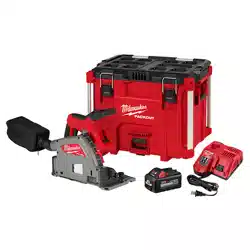Loading ...
Loading ...
Loading ...

11
OPERATION
WARNING
To reduce the risk of injury, always
wear proper eye protection marked
to comply with ANSI Z87.1.
When working in dusty situations, wear appro-
priate respiratory protection or use an OSHA
compliant dust extraction solution.
Keep hands away from the blade and other mov-
ing parts.
Always remove battery pack before changing
or removing accessories. Only use accessories
specically recommended for this tool. Others
may be hazardous.
Kickback causes and related warnings
- Kickback is a sudden reaction to a pinched, jammed
or misaligned saw blade, causing an uncontrolled
saw to lift up and out of the workpiece toward the
operator;
- When the blade is pinched or jammed tightly by
the kerf closing down, the blade stalls and the mo-
tor reaction drives the unit rapidly back toward the
operator;
- If the blade becomes twisted or misaligned in the
cut, the teeth at the back edge of the blade can dig
into the top surface of the workpiece causing the
blade to climb out of the kerf and jump back toward
the operator.
Kickback is the result of saw misuse and/or incor-
rect operating procedures or conditions and can be
avoided by taking proper precautions as given below:
• Maintain a rm grip with both hands on the
saw and position your arms to resist Kickback
forces. Position your body to either side of the
blade, but not in line with the blade. Kickback
could cause the saw to jump backwards, but Kick-
back forces can be controlled by the operator, if
proper precautions are taken.
• When blade is binding, or when interrupting a
cut for any reason, release the trigger and hold
the saw motionless in the material until the
blade comes to a complete stop. Never attempt
to remove the saw from the work or pull the saw
backward while the blade is in motion or Kick-
back may occur. Investigate and take corrective
actions to eliminate the cause of blade binding.
• When restarting a saw in the workpiece, centre
the saw blade in the kerf and check that saw
teeth are not engaged into the material. If saw
blade is binding, it may walk up or Kickback from
the workpiece as the saw is restarted.
• Support large panels to minimise the risk of
blade pinching and Kickback. Large panels tend
to sag under their own weight. Supports must be
placed under the panel on both sides, near the line
of cut and near the edge of the panel.
• Do not use dull or damaged blades. Unsharpened
or improperly set blades produce narrow kerf caus-
ing excessive friction, blade binding and Kickback.
• Blade depth and bevel adjusting locking levers
must be tight and secure before making cut. If
blade adjustment shifts while cutting, it may cause
binding and Kickback.
• Use extra caution when sawing into existing
walls or other blind areas. The protruding blade
may cut objects that can cause Kickback.
• Adjust the cutting depth to the thickness of the
workpiece. Less than a full tooth of the blade
teeth, or less than 1/8" of the blade, should
be visible below the workpiece. The less blade
exposed, the less chance of binding and Kickback.
Before cutting, be sure depth and bevel adjustments
are tight.
• Stay alert. Any distraction can cause twisting or
binding. Repetitive cuts may lull the user into care-
less movements.
Selecting the Speed
The RPM of tool can be changed by turning the speed
control dial. Variable speed dial settings range from
one (1) through six (6). Higher numbers correspond
to higher speeds and lower number correspond to
lower speeds.
General Operation
Always clamp the workpiece securely on a saw horse
or bench. See "APPLICATIONS" for the correct way
to support your work in dierent situations.
1. Draw a cutting line. Place the front of the shoe on
the edge of the workpiece without making blade
contact. Hold the main handle with one hand and
the front handle with the other.
2. Line up the sight line on the front and back of
tool with your cutting line. The sight line indi-
cates where the blade is cutting.
Tool with a guide rail:
Position (A) indicates the inside edge of the cut
at every bevel angle.
Tool without a guide rail:
Position (A) indicates the inside edge of the cut
at 0º bevel.
Position (B) indicates the inside edge of the cut
at 45º bevel.
A B
Loading ...
Loading ...
Loading ...
